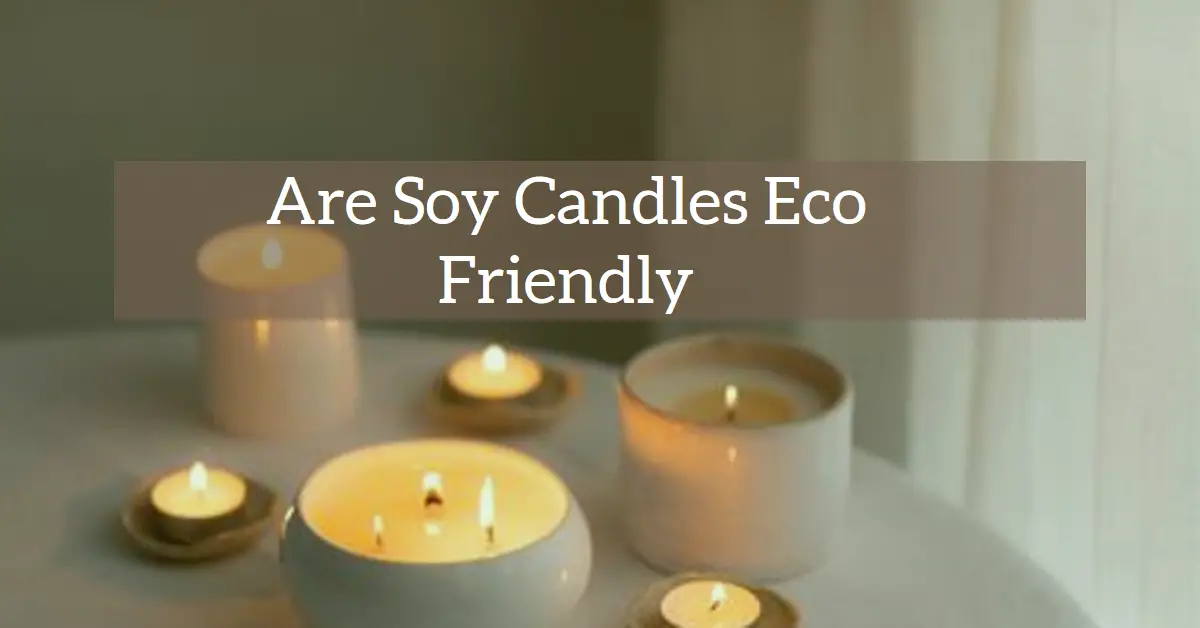Candles make homes feel cozy and smell delightful. But not all candles are created equal when it comes to ecological impact. Soy candles have exploded in popularity as an eco-friendly alternative to paraffin wax candles.
But do soy candles live up to their reputation for sustainability? This article will dive into an in-depth analysis of the environmental pros and cons of soy candles to determine if they truly are a greener choice.
The Rise of Soy Candles
Soy wax first started being produced commercially in the 1990s as an alternative to petroleum-based paraffin wax. It quickly became adopted across the candle industry.

Today, soy wax is one of the most common candle ingredients. The global soy candle market continues to expand at a compound rate of over 5% annually.
This immense growth is largely driven by consumer demand for natural and eco-friendly products. Soy has filled this market need for sustainable candles.
But why exactly are soy candles considered greener than the traditional paraffin candle? Let’s analyze the differences.
Soy vs Paraffin Wax: Sustainability Comparison
The core reason soy candles are touted as eco-friendly comes down to the different wax sources:
Soy Wax
- Made from soybean oil
- Renewable crop-based resource
- Biodegradable material
Paraffin Wax
- Made from petroleum oil
- Non-renewable fossil fuel-based resource
- Not readily biodegradable
Since soy wax comes from annually renewable soybeans, it has a clear sustainability advantage over paraffin derived from finite crude oil reserves.
But despite this win for soy, some environmentally-minded consumers argue soy candles aren’t as green as they seem. Let’s look closer at some potential downsides.
The Environmental Downsides of Soy Candles
While greener than paraffin, soy candles do come with some ecological considerations:
Soybean Agriculture Concerns
Much of the world’s soybean farming involves clearing forests for cropland, heavy pesticide use, and monoculture planting. These practices raise sustainability issues around soybeans as a renewable resource.
However, candle makers can avoid these impacts by sourcing soy wax from organic or responsibly grown soybeans.
Genetically Modified Organisms (GMOs)
Up to 80% of soybean crops are genetically modified. Many consumers see GMOs as unnatural and risky. Seeking non-GMO soy wax is an option for candle makers concerned about GMO-free ingredients.
Transportation Emissions
The global soy wax supply chain can burn significant fossil fuels in transport from South America to production facilities. Sourcing from regional growers reduces transportation miles.
Intensive Processing/Purification
Converting raw soybean oil into refined wax requires multiple energy-intensive processing steps including hydrogenation and bleaching. This processing does consume resources.
Wasteful Product Disposal
Like any consumer good, improperly disposed of soy candles can end up in landfills. Reusable glass containers and soy wax create less waste than single-use plastic jars.
Palm Wax Blends
Some “soy” candles mix in cheap palm wax which shares palm oil’s sustainability challenges around habitat destruction. Opt for 100% soy wax.
While soy wax has upsides, consumers should be aware of these potential environmental impacts of soy candle production.
How to Make Soy Candles More Eco-Friendly
The good news is that conscientiouscandle makers can take steps to maximize the eco-friendliness of their soy candles:
- Seek organic soy wax – Support organic agriculture over intensive industrial farming.
- Use regional soy wax – Source from local soybean farmers to reduce transport miles.
- Avoid GMOs – Use verified non-GMO soy wax for an all-natural product.
- Minimal processing – Look for wax processed via cold pressing vs. high heat hydrogenation.
- Use eco-friendly dyes – Plant-based dyes are safer and greener than artificial colors.
- Choose cotton wicks – Cotton wicks from sustainable sources burn cleaner than other materials.
- Reusable glass containers – Glass jars are endlessly reusable unlike single-use plastics.
- Biodegradable labels + wrappers – Avoid plastic labels and wrappers that create waste.
- Natural scents – Essential oils give candles a lighter eco-footprint than synthetic fragrances.
Following these tips for responsible production and sourcing enables makers of soy candles to deliver a truly eco-friendly product.
Comparing Soy vs Beeswax Candles
Beeswax is another popular natural candle wax. How does it compare to soy in terms of sustainability?
Soy Wax Pros
- Uses rapidly renewable plant resource
- Doesn’t require raising animals
- Carbon capturing crop if responsibly grown
- Lower cost wax
Beeswax Pros
- Uses natural insect-produced wax
- Encourages bee population growth
- No intensive agriculture required
- Low processing requirements
Both waxes have advantages. Soy wax edges out beeswax on metrics like carbon footprint and direct environmental impact. But supporting beekeepers by choosing beeswax candles also benefits ecosystems by boosting bee populations.
Ultimately soy wax and beeswax are much more eco-friendly than paraffin wax. Both give conscientious consumers great natural wax options.
Fragrance Considerations
Beyond wax type, candle fragrance also impacts environmental friendliness. Here are tips for choosing greener scents:
- Essential oils – Plant-derived and biodegradable but can be costly.
- Natural botanical extracts – Eco-friendly but light throw.
- Phthalate-free synthetic fragrances – Avoid hormone-disrupting chemicals.
- Unpigmented fragrances – Pigments create potential waste.
- Vegan fragrances – Ensure no animal derived ingredients.
- Lower percentages – Use less fragrance for lighter footprint.
Seeking soy candles scented with natural essential oils is the best path for maximizing fragrance sustainability.
The Last Word on Soy Candles and the Environment
When responsibly produced using natural practices, soy wax candles can rightly be considered a green product. Choosing makers who source mindfully, avoid GMOs, use eco-friendly dyes/wicks, and reduce waste demonstrates that soy candles can meet ecological standards.
Small-batch artisanal soy candle companies offer high quality options with conscientious sourcing and production values. Support these makers for candles that are gentler on the planet.
While not perfect, soy wax candles are a far more renewable and less toxic choice than conventional paraffin candles. When combined with eco-friendly business practices, soy candles deliver on their reputation as an environmentally-friendly lighting product that burns cleaner.
